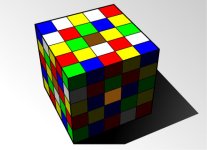ruby sparks
Contributor
"People universally believe that objects look colored because they are colored, just as we experience them. The sky looks blue because it is blue, grass looks green because it is green, and blood looks red because it is red. As surprising as it may seem, these beliefs are fundamentally mistaken. Neither objects nor lights are actually “colored” in anything like the way we experience them. Rather, color is a psychological property of our visual experiences when we look at objects and lights, not a physical property of those objects or lights. The colors we see are based on physical properties of objects and lights that cause us to see them as colored, to be sure, but these physical properties are different in important ways from the colors we perceive".
[1999, attributed to Dr Stephen Palmer, Professor of Psychology (speciality: Cognition), Visual Perception Laboratory, University of California at Berkeley].
https://plato.stanford.edu/entries/color/
-----------------------------------------------------------------
Claim 1: objects are not themselves coloured, they do not have colour.
Claim 2A: Colour is a psychologically-experienced 'mental' phenomenon only. Colour does not really exist other than in this way.
Claim 2B: Colour is a psychologically-experienced 'mental' phenomenon of consciousness only. Colour does not really exist other than in this way.
I think claim 1 is the easier and more recognised to be the case. I might hold that one quite strongly.
Claim 2A is, I think, not something that can be shown to be the case by any reasonable standard and is therefore (I would separately claim) an unresolved issue, but it is my inclination to go along with it and so I will start off defending the statement quoted above (which is apparently in blue).
Claim 2B is slightly more onerous, and may be even more up for debate, imo.
Does anyone have any views on the topic?
[1999, attributed to Dr Stephen Palmer, Professor of Psychology (speciality: Cognition), Visual Perception Laboratory, University of California at Berkeley].
https://plato.stanford.edu/entries/color/
-----------------------------------------------------------------
Claim 1: objects are not themselves coloured, they do not have colour.
Claim 2A: Colour is a psychologically-experienced 'mental' phenomenon only. Colour does not really exist other than in this way.
Claim 2B: Colour is a psychologically-experienced 'mental' phenomenon of consciousness only. Colour does not really exist other than in this way.
I think claim 1 is the easier and more recognised to be the case. I might hold that one quite strongly.
Claim 2A is, I think, not something that can be shown to be the case by any reasonable standard and is therefore (I would separately claim) an unresolved issue, but it is my inclination to go along with it and so I will start off defending the statement quoted above (which is apparently in blue).
Claim 2B is slightly more onerous, and may be even more up for debate, imo.
Does anyone have any views on the topic?
Last edited:

